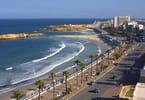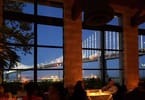Nanomboka tany am-boalohany ny mpanamboatra divay Bordeaux
Bordeaux, formerly known as Burdigala, dates back to the 3rd century when the Celtic tribes decided to settle in a beautiful spot, located on the western coast of the Baronne River. Latin Poet, Ausonius, first recorded mention of wine production in Bordeaux in AD 350 and a château still bears his name, the “Château Ausone.”
In addition to the natural grandeur, it was a transit point between the Atlantic Ocean, the Mediterranean Sea and the Iberian Peninsula. As wine making was initiated and trade grew, the residents became prosperous. Others found the locale delightful and by 56 AD, Julius Caesar and his lieutenant, Crassus, had conquered the area and prosperity continued to increase, making the city a major commercial center during the Roman Empire.
For the next 3 centuries the wine trade developed as did massive building and construction, including an amphitheater, temples, and luxurious homes, making it one of the largest cities in south Gaul with a population of over 20,000.
During the following centuries, Bordeaux experienced a complex mix of politics, economics, and love affairs – finally arriving at the 12th century – a golden age for the city. Artisans settled in the faubourgs, (the parts of the town outside the walls), the wine trade, conducted mainly with the English, was the main reason for the accumulation of wealth by the bourgeois of the Bordelaise and it marked the beginning of a democracy, allowing citizens to have a role in local government.
Tantaran'ny voaloboka
Grapevines have been growing in the Bordeaux region for more than 2000 years. During the Roman occupation a resistant grapevine was imported (perhaps from the Balkans), called Biturica. During the spread of Christianity, wine played a part in the religious services and, as the population grew – so did the increase in grape growing. Claret, a dark rose wine prized by the English court, established a monopoly of wine exported to England and vine growing expanded to Fronsac, Saint-Emillion, Cadilac, Langon.
The cultivation of grapes, and the production of wine in Bordeaux was unlike other French wine regions for here the industry was developed by merchants and not by monks.
Nandritra ny 17th ary 18th centuries the Dutch imported the wines of Bordeaux due to its long preservation qualities. It was also during this period that Dutch engineers drained the marshy Medoc and... VAKIO NY ARTICLE TRANO AO WINES.TRAVEL
INONA NO HALAINA AMIN'Ity ARTICLE ITY:
- Artisans settled in the faubourgs, (the parts of the town outside the walls), the wine trade, conducted mainly with the English, was the main reason for the accumulation of wealth by the bourgeois of the Bordelaise and it marked the beginning of a democracy, allowing citizens to have a role in local government.
- For the next 3 centuries the wine trade developed as did massive building and construction, including an amphitheater, temples, and luxurious homes, making it one of the largest cities in south Gaul with a population of over 20,000.
- During the spread of Christianity, wine played a part in the religious services and, as the population grew – so did the increase in grape growing.























